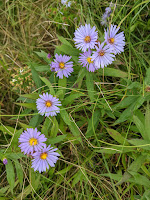 |
| A New Mask! |
The end of 2020 could not come soon enough! I bought a new mask for the end of the year holidays; I survived the year; my gardens survived the drought. But before 2020, survival was never the measure of success or happiness. Let's hope that 2021 brings us back closer to the lives we once knew.
Here are some of my gardening goals for the new year:
Goal 1: Continue to Re-wild, reduce lawns and expand natural areas! Goal 2: Create solutions and opportunities by building a rain garden to capture storm-water and create new habitats for water-tolerant plants and insects!
Goal 3: Learn to adapt by putting drought-tolerant species in full-sun areas and moving others that required excessive watering during last year's drought to a part-sun garden that I expanded in the fall! These are not my only goals for the year, but they match the theme of recovery for the new year. So with
these goals in mind, here are a few of the plants I am growing from seeds:
 |
| Iris Versicolor in the wild, Strafford NH |
For the Rain Garden:
I have selected three plants from the Wild Seed Project this year to go in the rain garden. All three are smaller plants that will go in the understory, almost like a ground cover. Closed
gentian (Gentiana clausa) is small, 1-foot tall plant that likes wet woods and meadows. Two other plants I am starting from seeds purchased from the Wild Seed Project are: Blue Lobelia (Lobelia siphilitica) grows to about 18 inches and Iris versicolor grows to 2 to 3 feet in height and likes average to wet soils. I'm unsure how these darker blue and purple plants fit together as an understory. This will very much be a work in progress.
 |
| Thalictrum pubescens |
My hope is that some of the wild seeds I have collected will take center stage in the rain garden. In particular, I am starting
Tall Meadow Rue, Thalictrum pubescens, from roadside seeds collected in Stafford, NH, that can get six feet or taller in full sun. I hope this will catch the eyes of both humans and insects alike as it did for this eastern bumblebee. Meadow rue is a tall, lanky plant that is very thin and open. This should allow light to pass through to smaller plants below and in front of it. To go with the tall meadow rue, I may try to add
Meadowsweet, Spiraea alba, from seeds collected in Biddeford Pool, Maine, and from Blue Job in Farmington, NH the year before. I did not have great success with germination.
 |
| Hop sedge! |
The last element for the rain garden and definitely the wild card will be some Hop sedge, Carex lupulina, from seeds I collected in Pawtuckaway State Park. A wetland environment is not complete or balanced if it is just wildflowers. Meadows need sedges, grasses and rushes or they are just gardens. This plant had such striking seed pods and my hope is that it may feed finches or other birds in the winter and continue to catch the eye when colors of summer are long gone.
Prairie Moon Nursery describes it as "an attractive Sedge, perfect for a rain garden." I was not aware of that when I collected the seeds so I may be in luck. Carex is certainly an important genus that is host to many species of insects.
For Full-Sun:
The drought we experienced in 2020 has made me reconsider the garden in the full sun. It needs plants that won't require unsustainable watering. It is not just about economics or environmentalism. I want plants that will sustain life without human intervention and without taking life away from our reservoirs. I also don't want a garden that wilts if neglected or demands daily watering. So I'm really excited to grow
Scrub oak, quercus ilicifolia, from acorns collected on the trail at the Ossipee pine barrens which tolerates dry, gravelly soils. Once established, it should not require watering at all.
According to GoBotany "Scrub oak is one of the smaller and more gnarled oaks in New England, rarely exceeding 12-20 feet in height. Also called bear oak, reportedly because only bears consume the bitter acorns." I don't expect any bears, but this is the perfect size oak for urban settings. It can provide some level of screening from the street without shading out my whole yard. Critically, according to Douglas Tallamy's
Native Plant Finder on the National Wildlife Federation web site, there are 407 species of buttlerfly that rely on oaks as a host plant in the Portsmouth area. Oaks are the #1 of all plant species in terms of supporting caterpillars and birds.
Behind the oaks and under the shade of a sugar maple tree, I plan to add
Pink corydalis, Capnoides sempervirens, collected from seeds in Pawtuckaway State Park. I don't know what insects or caterpillars may interact with this plant which is a biennial. However, it has such amazing colors and appearance and it should do very well in the dry shade. I found it near the summit of the small mountains in Pawtuckaway that are shaded, acidic and dry. If it germinates and grows, it should be a great plant for dry shade which can be challenging for gardens.
Two other full sun plants that I am growing from wild seeds are
Nannyberry, Viburnum lentago, from seeds collected in the Lee Town Forest and
Virginia Rose, Rosa virginiana from Biddeford Pool, Maine. Both are great plants for wildlife. The viburnums I expect will take 2 years to germinate.... the Virginia Rose I hope to get to germinate this year because I pulled apart the fruits, something I failed to do last year and did not see any seeds germinate until the very end of the summer.
So much to look forward to in the coming year. Let's make it one to remember in our gardens and in the lives we share!









Comments
Post a Comment